Chevrolet Spark Owners Manual: Head Restraints
Warning
With head restraints that are not installed and adjusted properly, there is a greater chance that occupants will suffer a neck/ spinal injury in a crash. Do not drive until the head restraints for all occupants are installed and adjusted properly.
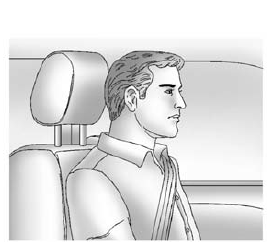
Adjust the head restraint so that the top of the restraint is at the same height as the top of the occupant's head. This position reduces the chances of a neck injury in a crash.
Front Seats
The front seats have adjustable head restraints in the outboard seating positions.
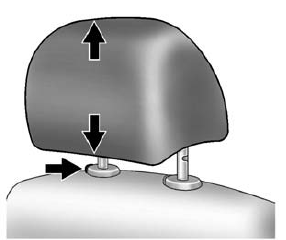
The height of the head restraint can be adjusted. Pull the head restraint up to raise it. Try to move the head restraint to make sure that it is locked in place.
To lower the head restraint, press the button, located on the top of the seatback, and push the head restraint down. Try to move the head restraint after the button is released to make sure that it is locked in place.
The front seat outboard head restraint is not intended to be removed. If removal is required see your dealer for assistance with removal. In the event of an emergency, the following can be used as removal and installation instructions. Store the removed head restraints in a secure place.
Reinstall the head restraint before the seating position is occupied.
Head Restraint Removal and Reinstallation
The front seat outboard head restraint can be removed according to following instructions:
- Partially recline the seat rearward. See “Front Seats” for additional information.
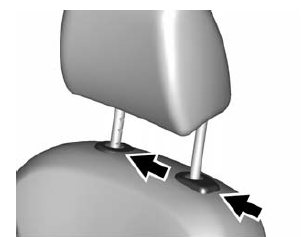
- Press both buttons on the head restraint posts at the same time, and pull up on the head restraint.
To reinstall the head restraint:
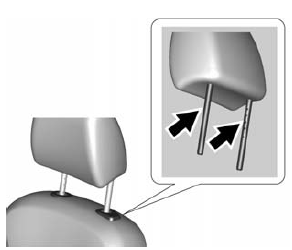
- Insert the head restraint posts into the holes in the top of the seatback. The notches on the posts must face the driver side of the vehicle.
- Push the head restraint down.
If necessary, press the height adjustment release button to further lower the head restraint.
See ‘Head restraints’ in the owner manual.
- Try to move the head restraint to make sure that it is locked in place.
Rear Seats
The vehicle's rear seats have adjustable head restraints in the outboard seating positions.
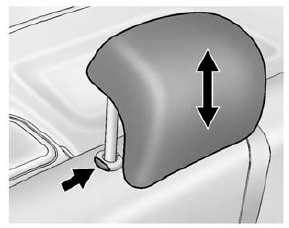
The height of the head restraint can be adjusted. Pull the head restraint up to raise it. Try to move the head restraint to make sure that it is locked in place.
To lower the head restraint, press the button, located on the top of the seatback, and push the head restraint down. Try to move the head restraint after the button is released to make sure that it is locked in place.
The rear seat outboard head restraint is not intended to be removed . If removal is required see your dealer for assistance with removal. In the event of an emergency, the following can be used as removal and installation instructions. Store the removed headrests in a secure place.
Reinstall the head restraint before the seating position is occupied.
Head Restraint Removal and Reinstallation
The rear outboard head restraint can be removed according to following instructions:
- Partially fold the seatback forward. See Rear Seats on page 3-8 for more information.
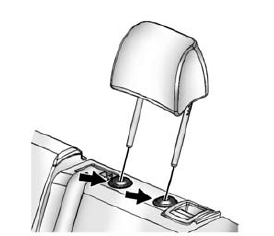
- Press both buttons on the head restraint posts at the same time and pull up on the head restraint.
Warning
With head restraints that are not installed and adjusted properly, there is a greater chance that occupants will suffer a neck/ spinal injury in a crash. Do not drive until the head restraints for all occupants are installed and adjusted properly.
To reinstall the head restraint:
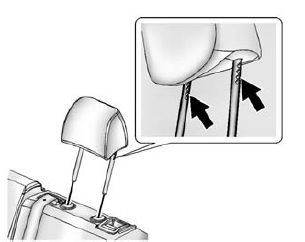
- Insert the head restraint posts into the holes in the top of the seatback. The notches on the posts must face the driver side of the vehicle.
- Push the head restraint down.
If necessary, press the height adjustment release button to further lower the head restraint.
See Head Restraints on page 3-2.
- Try to move the head restraint to make sure that it is locked in place.
If you are installing a child restraint in the rear seat, see “Securing a Child restraint Designed for the LATCH System” under Lower Anchors and Tethers for Children (LATCH System) on page 3-40.
 Front Seats
Front Seats
...
Other materials:
Customer Assistance Offices
Chevrolet encourages customers to call the toll-free number for assistance. However,
if a customer wishes to write or e-mail Chevrolet, the letter should be addressed
to:
United States and Puerto Rico
Chevrolet Motor Division
Chevrolet Customer Assistance
Center
P.O. Box 33170
Detroit, MI ...
Brake Assist
The Brake Assist feature is designed to assist the driver in stopping or decreasing
vehicle speed in emergency driving conditions. This feature uses the stability system
hydraulic brake control module to supplement the power brake system under conditions
where the driver has quickly and forcef ...
Filling a Portable Fuel Container
Warning
Filling a portable fuel container while it is in the vehicle can
cause fuel vapors that can ignite either by static electricity or other means. You
or others could be badly burned and the vehicle could be damaged. Always:
Use approved fuel containers.
Remove the container from the ...

